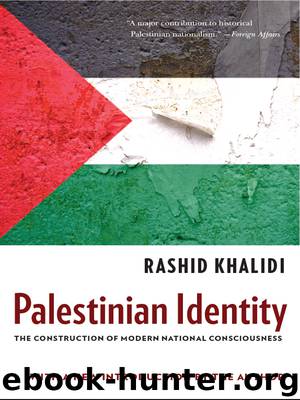Palestinian Identity by Rashid Khalidi

Author:Rashid Khalidi
Language: eng
Format: epub, pdf
Tags: Political Science/International Relations/General
Publisher: Columbia University Press
Published: 2011-09-25T16:00:00+00:00
II
Among the factors that caused the Arab population of Palestine to identify with the country in the years immediately before World War I, several stand out. We have already touched on many of these, but it is worthwhile reiterating and redefining them before going on to look at the years after World War I when so much changed so fast. First among these factors was a religious attachment to Palestine as a holy land on the part of Muslims and Christians (as well as by Jews, of course), which we have glimpsed repeatedly in earlier chapters. This attachment was felt by followers of both faiths elsewhere, but it was particularly strong for those Christian and Muslim Arabs who lived in Palestine.
Although Muslims and Christians had somewhat different conceptions from one another of what made Palestine a holy land, and of its boundaries and extent, they shared a similar general idea of the country as a unit, and as being special and holy. In the Christian case, as Alexander Schölch has pointed out most clearly (in the context of ascertaining “the extent to which it is at all meaningful to write a history of Palestine during a certain phase in the nineteenth century when there was no administrative unit with this name and when this area’s ‘borders’—in other words, the area’s historical-geographical identity—were contested”), this conception was firmly based on the biblical definition of the country as running from “Dan to Beersheba.”15 It was reinforced by the boundaries of the jurisdiction of the Greek Orthodox and Latin Patriarchates and the Protestant Episcopate of Jerusalem, all three of which included the entirety of Palestine irrespective of the Ottoman administrative divisions, which changed from time to time.
Both Schölch and Yehoshua Porath have described how the Muslim perception of Palestine as a holy land—it is indeed called “al-ard al-muqaddasa” [meaning “the holy land”] in the Qur’an (5:21)—developed over time.16 This took place notably through such genres as the “Fada’il al-Quds” literature referred to briefly in chapter 2, which praised Jerusalem, Hebron, and other parts of Palestine, and which was widespread before, and even more so after, the Crusades.17 This literature reinforced the sense for Muslims in which Palestine was an entity, albeit a sacred rather than a political one. Also important in this regard were annual seasonal pilgrimages to local holy sites, notably the Nabi Musa celebration, which traditionally attracted thousands of Muslim pilgrims from all over the country to a site identified with Moses by Muslims, at a twelfth-thirteenth century shrine located halfway between Jerusalem and Jericho.18
Various authors have also described how two more factors helped to shape the local inhabitants’ conception of the country: the first was Ottoman administrative boundaries, and the second was the ambitions and aspirations of the European powers in Palestine. As far as the first is concerned, we have seen that from 1874 onwards, the sanjaq of Jerusalem, including the districts of Jerusalem, Bethlehem, Hebron, Beersheeba, Gaza, and Jaffa, was a separate unit administered independently from any other Ottoman province, and as such was under the direct authority of Istanbul.
Download
This site does not store any files on its server. We only index and link to content provided by other sites. Please contact the content providers to delete copyright contents if any and email us, we'll remove relevant links or contents immediately.
| Arms Control | Diplomacy |
| Security | Trades & Tariffs |
| Treaties | African |
| Asian | Australian & Oceanian |
| Canadian | Caribbean & Latin American |
| European | Middle Eastern |
| Russian & Former Soviet Union |
The Secret History by Donna Tartt(18843)
The Social Justice Warrior Handbook by Lisa De Pasquale(12141)
Thirteen Reasons Why by Jay Asher(8792)
This Is How You Lose Her by Junot Diaz(6789)
Weapons of Math Destruction by Cathy O'Neil(6142)
Zero to One by Peter Thiel(5685)
Beartown by Fredrik Backman(5594)
The Myth of the Strong Leader by Archie Brown(5424)
The Fire Next Time by James Baldwin(5248)
How Democracies Die by Steven Levitsky & Daniel Ziblatt(5127)
Promise Me, Dad by Joe Biden(5087)
Stone's Rules by Roger Stone(5026)
A Higher Loyalty: Truth, Lies, and Leadership by James Comey(4842)
100 Deadly Skills by Clint Emerson(4840)
Rise and Kill First by Ronen Bergman(4701)
Secrecy World by Jake Bernstein(4643)
The David Icke Guide to the Global Conspiracy (and how to end it) by David Icke(4624)
The Farm by Tom Rob Smith(4434)
The Doomsday Machine by Daniel Ellsberg(4415)
